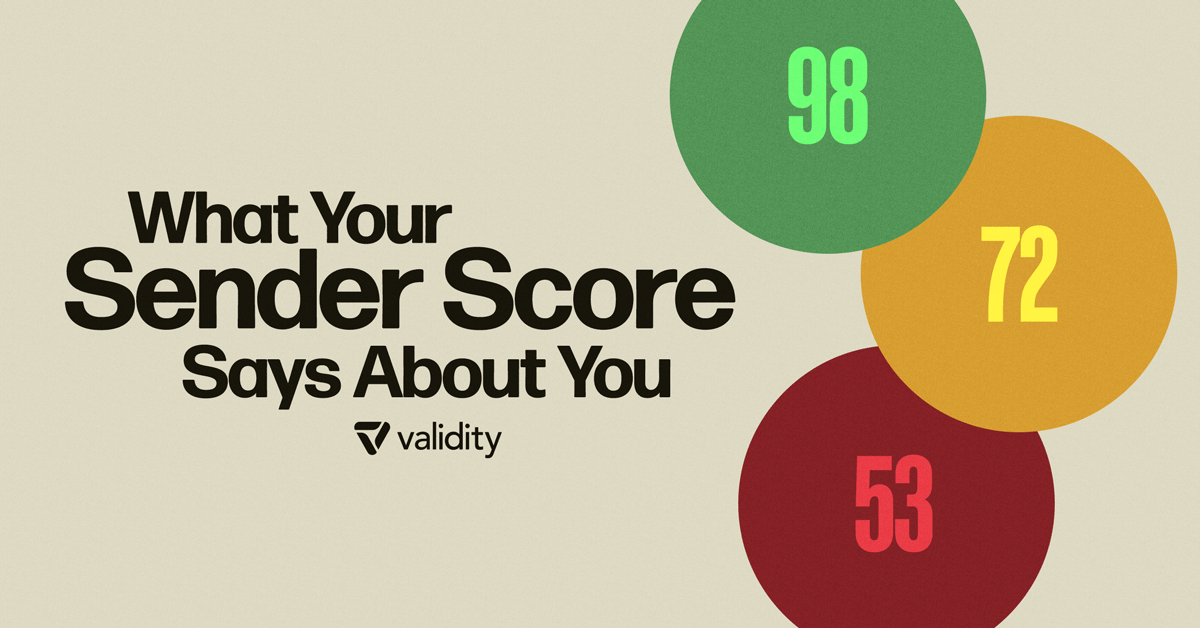Reaching the inbox is pivotal to your email program’s success. But if you don’t have a solid sender reputation, your emails may end up in the spam folder—or blocked entirely.
Luckily, your Sender Score can help you understand your sender reputation, learn how to improve it, and provide you with key insights needed to reach the inbox.
Let’s dive deeper into what your Sender Score says about you.
What is a Sender Score?
A Sender Score is a numerical representation of your sending reputation. It is derived from a proprietary Validity algorithm and is based on a scale of 0 to 100: 0 is the worst, and 100 is the best possible score.
Your Sender Score is determined by measuring your IP address’s performance across several metrics that are important to mailbox providers and subscribers. This score represents the overall health of your email program as it appears to receiving systems.
Why is this important?
Much like credit scores are used to gauge your credit worthiness, mailbox providers evaluate your Sender Score to measure the health and quality of your email program. This helps them determine whether to place your emails in the inbox, the spam folder, or to block them.
In other words, a high Sender Score is crucial to reaching the inbox.
Which factors determine my Sender Score?
Mailbox providers consider a vast amount of information when determining where your emails should be delivered, and each one has their own secret algorithm to calculate your trustworthiness.
Your Sender Score is based on similar factors to help establish a benchmark for how your messages are being perceived by mailbox providers.
These factors include:
- Complaint rate: Complaints occur when a subscriber marks an email as spam or junk. A high complaint rate may result in increased mailbox provider filtering, which can get your emails blocked or land them in the spam folder.
- Rejected rate: A rejected rate is the percentage of deployed email blocked by mailbox providers. Emails can be rejected for many reasons (high complaint rates, blocklistings, authentication issues, etc.).
- Volume: This represents the frequency and quantity of emails sent from a specific IP. While volume is not in itself good or bad, it is an important part of the overall reputation algorithm. For example, if an IP address sends 100 messages and receives 99 complaints, there’s an issue. But if an IP address sends 100,000 messages and receives 99 complaints, it’s likely okay.
- Unknown users: These are invalid addresses in your database (i.e., addresses with typos or addresses that don’t exist). A high unknown user rate tells mailbox providers that you aren’t following list hygiene best practices, and this is considered a spam-like characteristic.
- Messages filtered: This represents the percentage of deployed email that was filtered into the spam folder or otherwise did not make it to the inbox.
Depending on how your IP performs against these various reputation metrics, your Sender Score fluctuates. This allows you to keep an eye on your email program’s quality changes over time to see which factors could be impacting your deliverability.
What does your Sender Score say about your email program?
Sender Score is less than 70
A Sender Score below 70 indicates that one or more of the key metrics outlined above exceeds the acceptable thresholds determined by mailbox providers.
If you fall into this range, your email program needs improvement. Investigate the problematic metric(s) and assess your email practices against the fundamentals of email marketing.
Start by confirming that:
- Your emails are being authenticated. Mailbox providers view authenticated email as more trustworthy and are more likely to deliver it to the intended recipient.
- Spam complaints are being processed. All senders should ensure their IPs and domains are appropriately signed up for all available Feedback Loops (FBLs).
- You’re not listed on any blocklists. Blocklists range in their influence, but some can prevent your messages from ever making it through to your subscribers.
Sender Score is between 70-80
Senders with scores in this range have a solid grasp of email fundamentals but should continue following industry best practices and optimizing their email program.
Evaluate which of the key metrics assessed in your Sender Score are dragging down your IP and focus on correcting the issue.
Make sure that:
- Your subscribers have access to a preference center. A preference center allows them to choose the types of emails they want to receive and how often, which lowers the likelihood of complaints.
- Subscribers can easily unsubscribe from your program. While unsubscribes aren’t ideal, they’re preferable to spam complaints, which can hurt your sender reputation. Make the unsubscribe process simple to avoid spam complaints, and make sure you include a list-unsubscribe header in your emails.
- You’re maintaining a consistent sending volume. Large spikes in sending volume are viewed negatively by mailbox providers and can impact your ability to reach the inbox. If you need to increase your sending volume, do it gradually.
Sender Score is over 80
A Sender Score over 80 indicates that you have an excellent reputation and that your email program is following best practices. Congratulations!
However, even if your Sender Score is above 80, there’s still room for improvement. There are always opportunities to make your emails more engaging and boost your email ROI, such as:
- Personalizing your emails. Email personalization involves using subscriber data to create targeted, relevant email content and can significantly boost consumer retention rates, conversions, and positive engagement.
- Segmenting your email list. Segmentation ensures you’re delivering specialized content to your audience that resonates with them. For this reason, it is tied to major lifts in engagement.
- Incorporating new technologies. For example, AMP allows you to embed interactive elements like carousels, accordions, confirmation, and purchase buttons into your emails, creating a more engaging experience for your subscribers.
- The Sender Certification program from Validity. Certified senders enjoy benefits like preferential treatment at major mailbox providers, favorable reputation at critical spam filters, dedicated monitoring to ensure their email program is safe and secure, and a wealth of information that isn’t available anywhere else.
Conclusion
Now that you’re aware of what your Sender Score says about you, it’s time to find out where your IP stands. Sender Score data helps you find and interpret potential deliverability and reputation issues that may be preventing you from reaching your subscribers.
Knowledge is power, and Validity is here to help every email program reach its potential. Uncover more in-depth details about the factors that influence your sender reputation by downloading our eBook, Secrets of Best-in-Class Email Senders.
Source link




